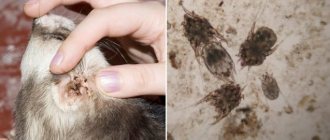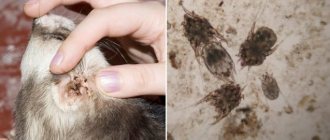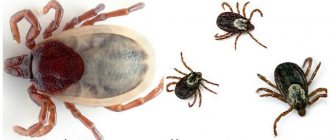Removing a tick is not always easy. If you followed our step-by-step guide to removing a tick and your cat is left with a stuck tick head, you need to know what to do. It is always advisable to speak to your veterinarian, who may ask you to bring your cat into the practice for a check-up.
If the head or mouthparts remain after removing the tick, do not panic. You have killed the tick and removed its body, preventing a serious risk of disease transmission. But any residual parts can still lead to infection at the attachment site.
Find out what you need to do to get rid of stubborn ticks once and for all.
What types of blood-sucking ticks can threaten cats?
All blood-sucking ticks, also called ixodid ticks, or ticks, pose a threat to cats. The most common types of ticks found in Russia are:
- Ixodes ricinus;
- Rhipicephalus sanguineus;
- Dermacentor reticulatus.
A cat can be bitten by any other ixodid tick - there is no fundamental difference in this.
Photo gallery: the most common types of ticks
The Ixodes ricinus tick is the most common type of bloodsucker.
The tick of the species Rhipicephalus sanguineus is the most common representative of this family in Russia
The mite Dermacentor reticalatus is a typical inhabitant of deciduous and mixed forests in Europe and Siberia
All these ticks have common properties: they necessarily feed on blood. Both adult, mature ticks and their larvae - nymphs - attack.
Typically, female ticks are found on animals - they need a lot of blood to reproduce, so they can remain at the site of the bite for up to several days. Nymphs and males need less blood, and often they leave the bite site on their own and unnoticed, thereby infecting the cat.
Ticks usually hide in grass, bushes, and low vegetation. They are found everywhere - from city courtyards and squares to fields and forests. Even if the cat does not leave the house, there remains a risk of being attacked by a tick brought into the apartment by people or other animals (usually a dog), as well as along with mushrooms collected in the forest, a wreath woven in a field, or greens collected at the dacha.
Ticks become active at air temperatures above +8 °C; their peak activity occurs in spring and autumn. But the possibility of a bite cannot be ruled out even in winter, for example, near a heating main or during a thaw on a thawed lawn.
The good news is that not all ticks are contagious. The range and frequency of diseases transmitted by ticks differ in different regions, and the most comprehensive information on a specific area can be obtained from the regional sanitary and epidemiological surveillance service.
What to do if the tick's head remains in the dog's body?
If attempts to remove the tick were unsuccessful and led to the body being torn off from the head of the insect, it is again advisable to seek help from a veterinarian, but if for some reason this cannot be done, the recommendations are as follows:
- Disinfect the bite site with alcohol or vodka.
- Lubricate the location with gasoline, kerosene, machine oil, and white alcohol. It is recommended to drip each substance drop by drop separately from each other, maintaining an interval of 5 minutes. It is necessary to ensure that the dog does not lick toxic substances!
- Then you need to lightly press down the head, and if it continues to remain in the dog’s body, it is recommended to make a loop out of thread, throw it over the insect’s head, tighten it tightly and try to pull it out. If it is not possible to pick up the head with a thread, you can use a thin, disinfected needle to pick out the parasite from the dog’s skin. When the head is completely removed, it is necessary to carefully treat the bite site with alcohol.
- After all the manipulations, you need to very carefully monitor the pet’s condition, and if alarming signs appear, such as an upset digestive system, fever, neurological disorders, etc., urgently take the dog to a veterinary clinic.
It is important to understand that not all manipulations to remove a tick or parasite remains are successful. Therefore, if possible, it is best to take the dog to the clinic
The doctor will make a small incision and quickly remove the tick or its remains - this is much safer than picking “blindly” on your own.
You need to understand that parasites can cause serious complications, and in order to protect your pet, drug therapy will be required:
- medications – Forticrab, Pirosan, Imizol;
- vitamins to improve immunity;
- heart medications - to strengthen blood vessels;
- hepatoprotectors – to restore the liver;
- in especially severe cases, blood purification from infection is indicated.
Attention! If the owner does not notice the tick or its remains, the animal will die - according to statistics, 98 out of 100 cases end in death. After removing the bloodsucker, it will be necessary to examine the animal for the presence of other ticks
In most cases, bloodsuckers attach themselves to open areas of the body - muzzle, ears, belly, neck, areas between the fingers. Therefore, these places should be inspected first.
After removing the bloodsucker, you will need to inspect the animal for the presence of other ticks. In most cases, bloodsuckers attach themselves to open areas of the body - muzzle, ears, belly, neck, areas between the fingers. Therefore, these places should be inspected first.
When is it necessary to perform a thorough examination of the animal?
It is necessary to carefully examine the cat every time it returns from a walk. The tick is easily visible in light or short hair. It is almost impossible to see an unattached tick if the fur is dark, long and thick, so it is recommended to supplement the inspection with combing with a fine-tooth comb.
The difference in size between well-fed and hungry ticks is quite large, so it is not difficult to detect the former on the skin of an animal
What does a tick look like on a cat's body?
Ixodid ticks, regardless of species, have common structural features:
- oblong body with small head;
- there is a shield on the body;
- four pairs of paws;
- length 3–4 mm;
- color - often different shades of black, gray and brown.
Tick nymphs are smaller and have three pairs of legs. The tick is hard to the touch and moves quickly. Under no circumstances should it be crushed, since these arachnids are not only carriers, but also natural reservoirs of diseases dangerous to animals and humans, the causative agents of which are transmitted from one generation of ticks to the next.
Having attacked the victim, the tick spends some time (from half an hour to two hours) looking for the most convenient place to bite. Its saliva contains an anesthetic substance, so the bite goes unnoticed by the victim. Having bitten, the tick begins to suck blood and increases in size to 1.5 cm, acquiring a reddish tint and the shape of a bean.
Photo gallery: what a bloodsucker looks like on a cat
The tick selects a place to bite within 0.5–2 hours
A recently embedded tick is difficult to detect on the skin of long-haired cats.
A sucked tick increases in size to 1–1.5 cm
Safety precautions when examining a cat
The cat must be examined on a smooth, preferably light-colored surface in order to notice the fleeing tick in time. Good lighting should be provided. You should not touch the tick with unprotected hands; all manipulations must be done with rubber gloves.
You need to wear rubber gloves when examining your cat.
You should not examine the cat on the sofa, carpet, or any other place where an escaped tick can easily hide and attack again. In case of detection of a bloodsucker, a small sealed glass container should be ready.
All ticks pose a danger to both humans and other animals in the house.
How to detect a tick on an animal's body
Cats that are often outdoors should be examined daily. The easiest way to detect the carrier of the infection is when it has already sucked and drunk blood, since in this case it increases in size.
You should start your search where insects attach themselves most often:
- neck;
- ears;
- inner thighs;
- armpits;
- stomach.
In these places, the vessels are located close to the surface, and the skin is thin and easy to puncture. When examining a cat, you need to carefully part the fur, since the parasite is very small.
If the carrier of the infection is not found during examination, this does not mean that it does not exist. Perhaps it has not yet attached itself, but is on the fur. It is advisable to comb the cat with a fine-toothed comb, sitting her on a white cloth. In this case, if the parasite falls out, it will not escape, because it will be clearly visible against a light background.
How to remove a tick if it has not yet attached itself
When removing a tick, be sure to wear gloves; you can also put a plastic bag on your hand. The tick cannot be crushed; it must be placed in a bottle. Touching a bloodsucker in itself is not dangerous, but there is no guarantee that when caught, the tick will not be crushed, and the causative agents of dangerous infections will not end up on the human skin and mucous membranes.
Any tick that has not attached itself must be burned . You should not throw it in the trash or down the drain - this will not destroy it.
How to tell if a tick has bitten your pet
If the tick moved freely, there is a high probability that it chose a place to bite and did not have time to penetrate the skin. Signs of a tick bite do not have typical differences - the site of penetration will look like a small tubercle of swelling or inflammation with a small pinpoint wound from which bloody fluid may ooze, since the tick's saliva contains substances that prevent blood clotting. The cat may scratch the bite site.
A tick can dig in absolutely anywhere, but more often it is found in secluded places where the skin is thin, the capillaries are close and where it will be difficult to scratch it off with a paw. Therefore, bloodsuckers are most often found:
- in the armpit and groin areas;
- on the stomach;
- behind the ears;
- at the withers;
- on the front of the neck;
- in the area under the tail.
If the tick has burrowed in for a long time, then its head and front legs may already be in the thickness of the skin. The head of this arachnid is fixed very firmly. To the touch, a sucked tick is a soft elastic tubercle located where it was not there before.
You should be careful not to mistake your cat’s nipples for ticks; Cats also have rudimentary (weakly expressed) nipples.
What to do
Every situation is different. If your cat is running around with part of a tick inside, they may not even realize it, but it's always a good idea to talk to your vet; in some cases, you may need to take steps to prevent an infestation.
- Disinfect the area
In situations where part of a tick becomes lodged in your pet, it is important to disinfect the area, some people do this by wiping it with alcohol (or a suitable disinfectant) and observing your pet so you can take action if necessary.
It is important not to treat the area with alcohol or disinfectant if the tick is still attached, as this may increase the risk of disease transmission.
© shutterstock
- Visit your veterinarian
In cases where the affected area becomes red, swollen or painful, or has a draining wound, it is time to make an appointment with your veterinarian right away.
Your veterinarian will be able to advise you on the best course of action depending on whether the mite remains are harmful to your cat or not.
If the affected area is already infected, your veterinarian may prescribe a topical antibiotic or a course of oral antibiotics for treatment.
How to remove a stuck tick
The longer the embedded tick remains on the cat, the higher the likelihood of transmitting to it an infectious dose of the pathogen sufficient to initiate the disease. The bloodsucker needs to be removed as quickly as possible, and the half hour to hour spent traveling to the vet can be critical. It is best to remove the tick yourself. It is advisable that someone hold the cat during manipulations.
The tick can be removed:
- using a special device;
- using improvised means - a clamp, tweezers, thread;
- by carefully unscrewing it with a gloved hand.
There are now a lot of special devices, but not all of them are suitable, since many of them do not involve twisting the tick, but only this ensures complete removal of the parasite. In addition, the tool must be reliable, convenient, and not put pressure on the bloodsucker’s abdomen.
Photo gallery: tick extraction devices and their use
The Tick Twister hook allows you to grab the tick at the base of its proboscis and easily remove it whole with a twisting motion, without putting pressure on the abdomen
Trix Tix Lasso also allows you to remove the tick completely and without putting pressure on it
The Tick Twister hook is simply rotated in one direction without changing the direction of rotation
You should not buy devices of this type - they involve capturing and pulling out the tick, while its head will remain in the skin and cause suppuration
The principle of operation of truly suitable tools is the same:
- The loop or clamp is placed as close as possible to the cat’s skin, to the base of the tick’s proboscis;
- The tick is fixed and removed using rotational movements.
- You can rotate it in any convenient direction. There is no pressure on the tick.
A Tick Twister hook costs 200–250 rubles, there are similar devices with a price of around 100 rubles. The cost of Trix Tix Lasso is 300–400 rubles.
Whatever device is offered in the store, it is important to understand exactly how it involves removing the tick.
If there is no device, you will have to use tweezers or a clamp. Do not grab the tick vertically or at an angle. The tips of the clamp or tweezers should be positioned strictly parallel to the cat's skin, as close to it as possible. Then the clamp or tweezers are rotated around the axis.
If you don’t have anything at hand, you can put on a glove, grab the tick with your fingers and, without putting pressure on the abdomen, turn it to one side. The method is suitable for those with thin fingers.
An even less convenient option is to remove the tick using a thread. A loop of thread is placed at the base of the proboscis as close to the skin as possible, and the tick is removed using a twisting motion. The method is suitable for calm cats with short hair.
What not to do when removing a tick
There is no need to fill the tick with vegetable oil, as well as aggressive liquids - alcohol, acetone and others. The tick will not leave and is unlikely to loosen its grip. In most cases, it will die, the tone of the proboscis will decrease, and its infected gastrointestinal contents will end up in the cat's bloodstream, significantly increasing the likelihood of infection.
Errors in gripping when removing a tick:
- jerking and pulling movements are unacceptable - the head will definitely come off;
- Do not grab it by the abdomen; the infected contents of the tick can enter the cat’s blood vessels.
The tick should be grabbed only at the base of the proboscis, without pressing on the abdomen
Video: how to properly remove a tick from an animal
What to do after removing a tick
After removing the tick, you need to ensure its integrity. The wound must be treated with hydrogen peroxide, dried and spot-cauterized with iodine or brilliant green. If the cat is allergic, give the antihistamine prescribed by the veterinarian.
If the head of the tick still remains under the skin, then if the cat is calm, you can remove it like a splinter using a sterile syringe needle. If the attempt is unsuccessful, you will have to contact a veterinarian. The head of the tick must be removed, otherwise a focus of purulent inflammation will form.
With a tick
The tick must be placed in a glass container with a secure lid and sent to the laboratory for examination. The tick should wait in the refrigerator for shipment; it is better to place a piece of cotton wool soaked in water in a bottle. The tick must be delivered to the laboratory alive and as soon as possible. If it is not possible to examine the tick, it must be burned.
After removal, the tick is placed in a glass container and taken to the laboratory for examination.
If the veterinary laboratory does not accept a tick for examination (and this happens), I contact a regular medical laboratory and order a test for a number of pathogens that interest me, including tularemia, since I live next to a natural outbreak. The fact that the tick was removed from the animal need not be disclosed. The downside is that the study is truncated compared to a veterinary laboratory, since the danger to people and animals is not the same for all pathogens. The advantages are convenience and speed; After 1–2 days, the results are sent by email. In case of a positive response from the laboratory, I would gain time both in the form of early treatment of the animal before the development of clinical manifestations, and for the prevention of the disease in myself by taking an antibiotic.
With cat
It is necessary to warn your cat's veterinarian about a tick bite. The pet should be monitored for 2–3 weeks, since this is the period of incubation periods for most tick-borne infections.
You should immediately contact your veterinarian if:
- behavioral changes: avoidance of contact;
- drowsiness;
- lethargy, apathy;
- nausea;
- redness;
- unsteadiness of gait;
There are only a few hours to provide timely assistance, so the owner must not waste time.
What not to do
You can often hear from various “experts” how to remove a tick from a cat quickly and easily. For example, by lubricating an already attached parasite with oil or alcohol. But these completely useless manipulations will not force the tick to leave its prey. Rather, it will lead to aggravation of the situation. Under the influence of external irritants, the tick will inject more enzymes into the animal’s blood, which will contribute to the rapid infection of the cat.
When removing a tick from an animal, you should not:
- Squash an insect against your pet's skin;
- Try to remove the tick by picking it out with a needle;
- Just pull it out with your hands;
- Burn with a cigarette directly on the animal’s body;
- Make lotions from caustic liquids, such as ammonia, gasoline or kerosene.
Why is a tick bite dangerous for a cat?
A tick bite for a cat is dangerous due to the following developments:
- tularemia;
- hemobartonellosis;
- piroplasmosis;
- theileriosis;
- anemia (in case of massive tick infestation).
Cats and dogs have species-specific resistance to the causative agent of tick-borne encephalitis and do not get sick from it.
Tularemia
Tularemia is an infection that is dangerous for both cats and humans, as well as other domestic animals, including rodents and birds. This is a natural focal disease, the causative agent is the bacterium Francisella tularensis. Foci of tularemia are dispersed throughout our country.
Tularemia is highly contagious; 10–50 bacteria are enough for a person to develop the disease. Human infection is possible through airborne, nutritional and contact routes. Transmission of bacteria through intact skin and mucous membranes, as well as intrauterine infection, is possible. Wild animals serve as natural reservoirs.
The incubation period in humans ranges from several hours to 3–7 days; in a cat 4–12 days. Tularemia is transmitted from cats to humans; no cases of human-to-human transmission have been reported. A cat can also become infected by eating infected rodents.
The disease can occur in acute or mild form; Symptoms are similar in cats and humans. Emergency preventive measures have been developed for humans: this is vaccination (before it, a test is taken to confirm that the person is not sick with tularemia at the time of vaccination) or prophylaxis with antibiotics. There is no specific prevention for animals.
Tularemia manifests itself:
- fever;
- inflammation of the lymph nodes with subsequent suppuration;
- damage to the spleen, liver, lungs with the formation of ulcers;
- general weakness;
- ulceration of the oral mucosa;
- exhaustion.
Without treatment, the cat will die. It can be treated well if diagnosed early. During therapy, it is necessary to isolate the sick animal.
Hemobartonellosis
Hemobartonellosis in cats is caused by Haemobartonella felis, which attacks red blood cells. The incubation period is 10–14 days. Clinical manifestations consist of:
- anemia;
- loss of appetite and weight;
- lethargy.
There may be attacks of fever. Noteworthy is the change in urine color - it becomes darker.
Cats can also become infected with this disease not only from ticks, but also during a fight with another cat. Unlike tularemia, hemobartonellosis is safe for humans. A sick cat easily develops associated infectious diseases. Without treatment, mortality can reach 30%; in treated cats, the mortality rate is 1%.
Video: feline infectious anemia
Piroplasmosis
Feline piroplasmosis is caused by Babesia Felis. It is diagnosed in Russia so far in isolated cases, mainly in animals aged 1–3 years, more often in the Siamese breed. This pathogen attacks red blood cells, causing their hemolysis (destruction), which leads to:
- development of anemia;
- darkening of urine;
- jaundice;
- weaknesses;
- loss of weight and appetite;
- fever.
Without treatment, the cat will die. The disease is safe for humans.
Massive breakdown of affected red blood cells is manifested by jaundice
Babesia Felis was discovered in 1937 by American researchers Dunning and Jackson, although it received its name a little later. At that time, the pathogen was found in Zimbabwe and South Africa. Even then, its danger to domestic cats was proven. Large wild cats are the reservoir of infection.
Theileriosis
Theileriosis occurs in the southern regions of Russia:
- Grozny region;
- Rostov region;
- south of the Stavropol Territory.
In other regions, cases are rare. It is caused by Theileria Felis, which affects the bone marrow, leukocytes, liver, kidneys, and lungs.
The disease manifests itself:
- general oppression;
- weight loss;
- severe dehydration;
- fever;
- enlargement of the spleen and lymph nodes;
- pallor of the mucous membranes;
- difficulty breathing.
In the absence of therapy, coma and death occur. Mortality reaches 90%. The disease has been little studied, and experience with its treatment is limited. The disease is safe for humans.
Features for pregnant cats and kittens
The peculiarities of pregnant cats and kittens include the special vulnerability of this category, since both of them have reduced immunity. Therefore, we should expect an earlier onset of the disease and a more aggressive course in them. Antibacterial therapy is indicated for pregnant cats for health reasons, and the life of an adult will be placed higher than the successful outcome of her pregnancy. Antibacterial and supportive therapy is also indicated for kittens. The tactics for managing each specific case are chosen individually by the attending veterinarian.
Prevention of tick attacks on pregnant cats and kittens is of great importance.
Section question - answer
When it is necessary to remove a tick so that the head is not left under the skin, it is better to first clarify which actions are permissible and which are not, and what is best to use for this purpose. All questions can be asked to a specialist on the website online.
Is it more difficult to remove a tick from a kitten?
Inna Zaikovskaya, 26 years old, Penza: “I’m going to get a kitten, but we have a private house. I'm afraid of ticks. Tell me, is it easy to remove them from kittens?”
Expert opinion Oleg Viktorovich Veremeev Veterinarian, Doctor of Veterinary Sciences.
“The principle is the same for adult cats and kittens. When ticks are removed from small animals, they do not resist so much and they often do not need to be wrapped in a diaper. In this regard, it is even easier to remove parasites.”
Where does a cat that doesn't go outside get ticks?
Valeria Kuznetsova, 33 years old, Stary Oskol: “I’ve already had to remove ticks from a cat twice, but she lives in our apartment and doesn’t go outside. Where are they from?
Expert opinion Oleg Viktorovich Veremeev Veterinarian, Doctor of Veterinary Sciences.
“I can immediately tell you several reasons for the appearance of such pests: people bring them home on clothes, on other things or pets that are still at home (for example, dogs). Then the parasites look for shelter and, if possible, attack smaller animals.”
Inspect even cats that don't go outside
What to do if the head of the tick remains under the cat’s skin?
Varvara, 39 years old, Tula: “I tried to unscrew the parasite, but it came off. Now his head remains under the skin. Do I need to do anything?
Expert opinion Oleg Viktorovich Veremeev Veterinarian, Doctor of Veterinary Sciences.
“I still advise you to remove a fragment of the parasite’s body. If this is not done, inflammation will develop; the worst-case scenario for the development of such a situation is sepsis. The principle of removing a head from a cat's skin is simple. It resembles the technique of removing a splinter. When you decide what to do if the tick's head remains in the cat's body, you need to remember 2 things: make a fold in the pet's skin, and try to remove the protruding fragment with tweezers. If that doesn't work, use a sterile needle. Then try the tweezers again."
Do cats get vaccinations?
Karina Podzhukis, 40 years old, Tambov: “I want to vaccinate the animal, since I have already removed ticks twice this season. Do cats get vaccinations?
Expert opinion Oleg Viktorovich Veremeev Veterinarian, Doctor of Veterinary Sciences.
"No. Cats are not vaccinated against diseases carried by ticks, but dogs are. This is explained by the fact that cats tolerate piroplasmosis more easily. Such animals are vaccinated against rabies and various viral diseases not associated with tick bites.”
What colors can a tick be?
Irina Shvetsova, 38 years old, Samara: “I’m not sure that I found a tick on the animal’s body. Tell me what colors they come in?”
Expert opinion Evgeniy Igorevich Bragin Entomologist, 19 years of scientific experience.
“There is a wide variety: yellow-brown, gray, brown, dark red. These are shades of ixodid, argasid parasites, which are more often found in cats.”
Ticks are found not only in bright (orange) colors, but also in other colors
Are there anti-tick tablets for cats and kittens?
Anastasia Masliy, 36 years old, Penza: “I want to protect my cat from parasites for a long time. Tell me, are there such pills?”
Expert opinion Oleg Viktorovich Veremeev Veterinarian, Doctor of Veterinary Sciences.
“Yes, of course, there are some for sale. For example, Bravecto. But at my own discretion, I do not recommend using them. Contact your veterinarian for advice."
What to do if the tick comes off?
Alina Chumakova, 28 years old, Kazan: “For the first time I removed a tick from an animal using a thread. I couldn't buy a special hook. What are my next steps?
Expert opinion Oleg Viktorovich Veremeev Veterinarian, Doctor of Veterinary Sciences.
“You will have to further remove this fragment, since an abscess soon appeared in this place. Inflammation can lead to complications."
Can larvae (nymphs) be dangerous for cats?
Veronica Soboleva, 32 years old, St. Petersburg: “I found some kind of pest on my cat. Similar to a tick, but not as large. Could this be a larva? Is she dangerous?
Expert opinion Oleg Viktorovich Veremeev Veterinarian, Doctor of Veterinary Sciences.
“It is the nymphs that pose a danger to young cats, as well as adult animals. They choose small animals as hosts. Sexually mature ticks usually attack large animals, people, artiodactyls, and cattle.”
Tick larvae are just as dangerous to cats as adult ticks.
How to protect your cat from ixodid ticks
Since favorable treatment outcomes for tick-borne infections are not always guaranteed, a particularly important role is played by protecting the cat from attacks by bloodsuckers. For this purpose, collars, sprays, and drops on the withers are used. It should be noted that not all manufacturers include in their formulations substances that are harmful specifically to ticks, so you should always carefully read the instructions for the product.
Typically, tick repellents contain the following substances:
- fipronil;
- etofenprox;
- permethrin;
- selamectin;
- ivermectin;
- pyriproxyfen.
There are many products available for protection against ticks, with different application methods and in different price categories. Reliable manufacturers are considered:
- "Merial";
- "Leopard";
- "Hartz"
- Bayer.
Frontline spray deserves special attention; it can be used both in pregnant and lactating cats, and in kittens from 2 days of age.
Frontline spray is suitable for pregnant cats and kittens
How to find a parasite
After each walk, it is advisable to inspect the animal for the presence of ticks. It looks like a flat brown drop, ranging in size from two to five millimeters. After the parasite drinks blood, its size can increase to one and a half centimeters, and it itself becomes like a gray wart. If you look closely, you can see the hooked legs and the point of the head.
The sooner the parasite is detected, the better. Once on the skin, it does not immediately dig into it, but within two hours it can look for a suitable place to bite. Therefore, examining your cat immediately after coming home can give you a chance to find the tick before it burrows into the skin.
- Most often, parasites burrow into the skin of the armpits, thighs, abdomen and behind the ears. In cats, they prefer the groin area.
- Having found a suitable place, the tick cuts the tissue and pushes its proboscis as deep as possible.
- With the help of an oral apparatus with teeth and hooks, the parasite is securely fixed in one position and begins to alternately suck out blood and lymph.
- While feeding, the tick injects special enzymes into the wound that relieve pain. Due to this, the animal does not show any anxiety, since it simply does not feel the presence of the parasite.
Interesting: Blood in a cat’s stool: causes and possible treatments
Therefore, in order to detect a tick on a cat, it should be carefully examined, felt or combed against the grain.
Prevention
The risk group includes cats (cats, kittens) walking freely on the street or in a summer cottage. You can protect them with the help of products that you can buy at the pharmacy or prepare yourself:
Sprays are the safest method of protection, but their effect is limited to a short period of time.
Drops: Products in liquid form are dripped onto the coat. They are absorbed into the skin and the protective effect can last for several months. But the composition of such drops is very toxic.
A collar is an excellent helper in protecting your pet. But you should only wear it when walking outside, as long-term contact with the skin can cause allergies.
Despite all the above measures, only constant attentive attitude towards your pet will save you from many unpleasant consequences.
Ticks are active in forests, parks, and meadows throughout the warm season. Owners of four-legged friends should know how to remove a tick from a cat and be able to get this parasite painlessly.
Pets kept indoors are also at risk. A person can bring ticks from the street on clothes and bags. Most often, parasites patiently lie in wait for their prey in the grass and thickets of bushes.
Lice in cats
The most common lice in cats is Frosticus subrostatus. These are small wingless insects that spend their entire lives on animals and can only survive for a few days without the animal. Lice are spread through direct contact or through infested brushes, combs and bedding. Eggs (nits) are “cemented” on the hairs of the coat. Lice are an irritant to your cat and cause severe itching, leading to your pet causing self-inflicted wounds. Lice are species specific, so effective treatment must include all cats in contact, but dogs do not need to be treated.











